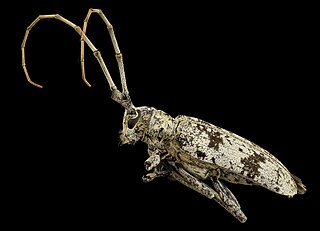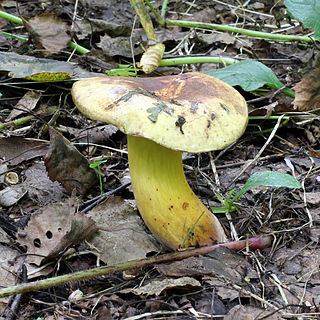
Psammodynastes pulverulentus, the common mock viper, is a species of snake native to Asia. It is one of the few snake species to possess three hemipenes.

Goes is a genus of longhorn beetles, containing the following species:

The smoky flying squirrel is a species of rodents in the family Sciuridae. It is monotypic within the genus Pteromyscus. It is found in Brunei, Indonesia, Peninsular Malaysia, and southern Thailand, but its range may be more extensive than currently mapped. Its natural habitat is subtropical or tropical dry forests. It is listed as endangered because of estimated population loss of 50% in past and future, judging from extensive and rapid habitat loss.

Cyanoboletus pulverulentus, commonly known as the ink stain bolete, is an edible bolete mushroom. It is found in deciduous and mixed forests, particularly on moist soil on slopes and under beech and oak trees. A common species, it is found in northern Asia, Europe, North Africa, Central and northern South America, and eastern North America. All parts of the mushroom will stain dark bluish-black after handling. The mushrooms used to be considered edible, but a recent study has revealed this mushroom hyperaccumulates arsenic and therefore its consumption should be restricted.

Zographus regalis is a species of beetle belonging to the family Cerambycidae.

Zographus oculator, the Orange-eyed Long-horn Beetle, is a species of flat-faced longhorn beetles belonging to the family Cerambycidae.
Sternotomini is a tribe of longhorn beetles of the Lamiinae subfamily. It was described by Thomson in 1860.
The purple swamphen has been split into the following species:
Paul Konrad was a Swiss geometrician and amateur mycologist.
Goes pulverulentus is a species of beetle in the family Cerambycidae. It was described by Haldeman in 1847, originally under the genus Monohammus. It is known from North America.
Zographus aulicus is a species of beetle in the family Cerambycidae. It was described by Bertoloni in 1849. It has a wide distribution in Africa.
Zographus cingulatus is a species of beetle in the family Cerambycidae. It was described by Per Olof Christopher Aurivillius in 1913. It is known from the Democratic Republic of the Congo, Angola, and Malawi.
Zographus lineatus is a species of beetle in the family Cerambycidae. It was described by Quedenfeldt in 1882, originally under the genus Quimalanca. It has a wide distribution in Africa.
Zographus nitidus is a species of beetle in the family Cerambycidae. It was described by Per Olof Christopher Aurivillius in 1914, originally Quimalanca. It is known from Uganda and the Democratic Republic of the Congo.
Zographus niveipectus is a species of beetle in the family Cerambycidae. It was described by Quedenfeldt in 1888, originally under the genus Sternotomis. It is known from the Central African Republic, Zambia, and the Democratic Republic of the Congo.
Zographus niveisparsus is a species of beetle in the family Cerambycidae. It was described by Louis Alexandre Auguste Chevrolat in 1844, originally under the genus Sternotomis. It is known from South Africa, Mozambique, and Zimbabwe.
Zographus plicaticollis is a species of beetle in the family Cerambycidae. It was described by James Thomson in 1868. It is known from South Africa and Namibia.
Zographus quadrimaculatus is a species of beetle in the family Cerambycidae. It was described by E. Forrest Gilmour in 1956. It is known from Tanzania.
Zographus scabricollis is a species of beetle in the family Cerambycidae. It was described by Quedenfeldt in 1882, originally under the genus Quimalanca. It has a wide distribution in Africa.

Agnocoris pulverulentus is a species of plant bug in the family Miridae. It is found in North America.







